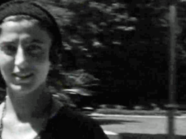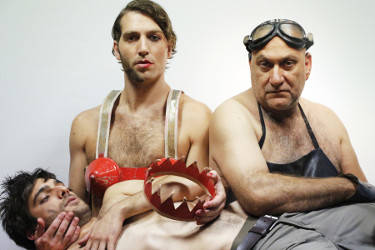D'Ambrosi's Hamlet Hallucinations at La MaMa
taly's Dario D'Ambrosi is a radical innovator of the theater who never ceases to shock. He is a former Italian soccer star and founder of the movement called Teatro Patologico (Pathological Theater). His plays investigate mental illness by grasping its vital artistic and creative aspects with the intention of restoring the "dignity of the fool." Having staged revolutionary interpretations of "Richard III" in 1996 and "Romeo and Juliet" in 2009, he is now taking on Hamlet with a new full-length work, “Hamlet Hallucinations.”
La MaMa E.T.C. is presenting the work's world premiere until November 3in its First Floor Theater, 74A East Fourth Street. Performed entirely in English, with a script that includes selections of the Bard's soliloquies, the play is set in the graveyard and essentially presents the story from the viewpoint of the gravedigger, who is played by D'Ambrosi himself. The cast also includes two bilingual Italian actors: the Prince of Denmark is played by Giacomo Rocchini and Hamlet's hallucinations, including the characters of his father, his mother, King Claudius and Ophelia, are played by Mauro F. Cardinali.
The theater of Dario D'Ambrosi often interprets epic and classical themes through the prism of mental illness. In this re-envisioning of “Hamlet,” D'Ambrosi makes the Prince into a childish young man who emerges from a grave where he has been buried in a pile of skulls, companions of his past. The script focuses on his obsessions, phobias, Oedipal complexes and misogyny. In Part 1, Hamlet is crystallized in an eternal rehearsal of his tragedy, having completely lost his sense of self. He hears voices and experiences the discontinuous thoughts of a schizophrenic.
His text includes big slices of the monologues, but has its meter broken and sometimes brutalized by direct, immediate, raving language. As Mauro F. Cardinali plays all the other characters in Hamlet's story, the audience is kept guessing about which character is hallucinating. In Part 2, Hamlet encounters the Cemetery's Mortician, D'Ambrosi, who confronts him over his treatment of Ophelia. We are not clear if we are witnessing Hamlet's hallucination or the Mortician's. The themes are the hallucinatory nature of modernity and the evasive strength of folly. The NY Times' D.J.R. Bruckner wrote, "Any piece by Mr. D'Ambrosi is about each member of the audience. A viewer who surrenders disbelief for a moment will be carried away in an unimaginable world of chaos, wit, bewilderment, mirth, anger, disgust and a kind of sweet sadness, and will leave it with a sense of relief and loss. The production has scenic design by Luisa Viglietti, who designs for Lina Wertmuller, among others.
Dario D'Ambrosi's last La MaMa production, "Medea" (2011), was presented last Spring at Wilton's Music Hall, London and was just named Best Show of 2013 by that prominent London institution, which lists as its patron HRH The Prince of Wales. D'Ambrosi first performed at La MaMa in 1980 and has been in residence there nearly every year thereafter. Rosette Lamont wrote in Theater Week, "The yearly appearance of the Italian writer/performer Dario D'Ambrosi at La MaMa is cause for celebration." He has written and directed over 14 plays, acted in 18 major films and TV movies, and written and directed three full-length films.






































i-Italy
Facebook
Google+
This work may not be reproduced, in whole or in part, without prior written permission.
Questo lavoro non può essere riprodotto, in tutto o in parte, senza permesso scritto.